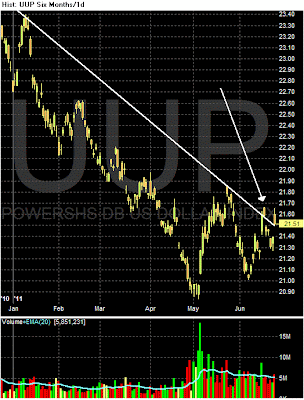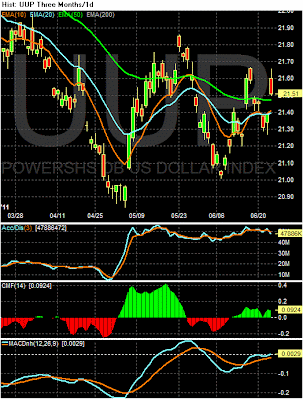- by New Deal democratIn the rear view mirror, Q1 GDP was revised up 0.1% to +1.9%. Monthly data focused on home sales. Both new and existing home sales for May declined slightly from April, but in the longer perspective simply continued to bounce along the bottom they first made two years ago. Durable goods orders fared better, up 1.9% from the previous month. New orders for non-defense capital goods, a component of the LEI, increased 5.8% from the month before. Durable goods may be the first signal that the Japan-induced slowdown in manufacturing is ending.
Virtually all of the coincident high-frequency weekly indicators show a complete stall or something close to it this week:
Highlighting the deterioration in tone, the
ICSC reported that same store sales for the week of June 18 increased 2.2% YoY, and decreased -0.7% week over week. The yearly comparison here has continued to decrease in the last few weeks.
Shoppertrak reported a 1.0% YoY increase for the week ending June 18 and a WoW increase of 8.6%. YoY weekly retail sales numbers had been a bright spot, but comparisons have been slowly weakening. This week marks the first time when same store sales have joined other indicators in signaling a real slowdown.
Similarly, the
American Staffing Association Index remained flat. The index has been rebenchmarked, so the new value is 87. This series is just barely above a stall, and is a significant danger sign. It is weaker than early 2007, but not trending down as during the recession.
Railfax was up 3.2% YoY for the week, or 9,200 carloads. Baseline traffic is actually down -0.14% from a year ago. Cyclical traffic is up 2.24% YoY. Intermodal traffic (a proxy for imports and exports) is up 2.71% compared with a year ago. Railfax continues to flirt more and more with going negative, and has almost done so on a carload basis.
The
BLS reported that initial jobless claims last week were 429,000. The four week average increased slightly to 426,250. We have stabilized under 430,000, but this is still considerably higher from earlier this year.
Weekly
BAA commercial bond rates remained the same at 5.73%. This compares with yields on 10 year treasury bonds decreasing .01% to 2.99%. The continuing decline in treasury rates shows fear of deflation, and the relative increase in corporate rates shows a slight increase in relative distress in the corporate market.
Adjusting +1.07% due to the 2011 tax compromise, the
Daily Treasury Statement showed that for the first 17 days of June 2011, $7109.4 B was collected vs. $115.2 B a year ago, for a decrease of $5.8 B, or -5% YoY. For the last 20 days, $139.2 B was collected vs. $131.6 B a year ago, for an increase of $7.6 B, or 5.7%. Use this series with extra caution because the adjustment for the withholding tax compromise is only a best guess, and may be significantly incorrect. Neverthless, that in the past few weeks some negative YoY comparisons have appeared is emphatically not good.
M1 was down -0.2% w/w, up 0.6% m/m, and up 13.1% YoY, so
Real M1 was up 9.7%.
M2 was up 0.1% w/w, up 0.5% m/m, and up 5.3% YoY, so
Real M2 was up 1.9%.
Real M1 remains very bullish, while Real M2 remains stuck in the caution zone under 2.5%
YoY weekly median asking house prices from 54 metropolitan areas at
Housing Tracker showed that the decline worsened -.2% to -4.7% The areas with double-digit YoY% declines increased by one to 10. The areas with YoY% increases in price decreased by two to 3.
There was some good news this week, however, and particularly so because it involves two areas that generally lead the economy:
Oil finished at $91 a barrel on Friday, which means it is now below the level of 4% of GDP (which according to Oil analyst Steve Kopits is the point at which a recession has been triggered in the past). Gas at the pump fell for the fifth week in a row, declining $.06 more to $3.65 a gallon. Gasoline usage at 9319 M gallons was +.8 higher than last year's 9241. This is the third time in four weeks that gasoline usage has exceeded last year, after a two month period of negative YoY comparisons. In other words, the Oil choke-collar continues to loosen.
The
Mortgage Bankers' Association reported that seasonally adjusted mortgage applications decreased 2.8% last week. It was 4.4% higher than this week last year. This is the fourth week in a row that YoY comparisons in purchase mortgages were positive. Except for the rush at the two deadlines for the $8000 mortgage credit, these are the first YoY increases since 2007. Refinancing decreased 7.2% w/w with a slight increase in mortgage rates.
Ultimately it is the loosening of the Oil choke collar and the bottoming of the housing market in prices as well as sales which will lead to a longer-term, more sustainable recovery in the economy (that, and fixing systemic financial risk and dealing with global wage arbitrage, prospects as to which Versailles has not shown the slightest interest). The improvement in housing and oil as shown above is helpful. The concern is that contractionary policy emanating from Versailles will swamp those effects.









































